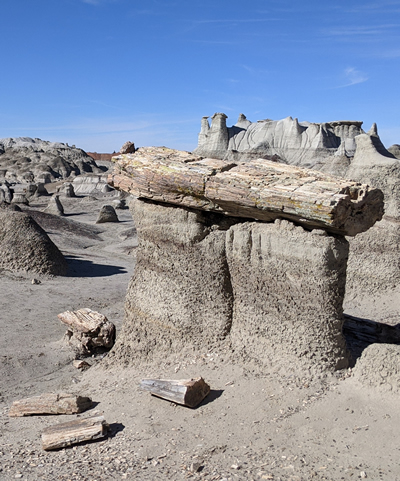
Frequently Asked Questions About Fossil Identification and Collecting

- Can I collect fossils I find in New Mexico?
- I think that I have found a dinosaur bone. What should I do?
- Where are good fossil collecting localities in New Mexico?
- What are the specific federal regulations regarding collecting fossils on public lands?
- Can I collect the fossils I find in New Mexico?
-
Yes and no, it depends on what kind of fossils you've found and where you found them. Collection is not permitted on Federal Parks, Monuments, or otherwise protected lands. "Casual collection" of common invertebrate and plant fossils is generally allowed on BLM and USFS lands unless specifcally prohibited. But, you can't use powered tools and can only collect a "reasonable amount" (up to 25 lbs per person per day) for non-commercial personal use (see regulations).
Vertebrate Fossils: Any vertebrate fossil (one that looks like a fossilized bone) found on federal, state, or tribal land cannot be legally collected without special permission. Vertebrate fossils include all creatures that had a backbone, like mammals and fish, as well as fossil shark teeth. Trackways and any other trace fossils made by vertebrates are also legally protected and cannot be collected without a research collection permit.
This protection is to ensure that these rare vertebrate fossils can be carefully excavated and studied by experienced paleontologists at research institutions, and can add to our understanding of our natural history heritage. Vertebrate fossils found on private land belong to the land owner, so permission must be obtained to collect from them as well. If you are determined to be part of a dinosaur excavation in New Mexico, you're best option is to contact one of the paleontology museums in New Mexico that runs a volunteer program.
Invertebrate Fossils: Plants and invertebrate animals (that don't have bones, like snails) are far more numerous than vertebrate fossils and are not accorded the same special legal protection on public lands. If you can collect mineral specimens, you generally can collect common fossils as well on public lands. Note that many public lands, like parks, monuments, and wilderness areas RESTRICT ALL COLLECTION of natural resources.
Please be aware of the rules that govern any particular spot before you collect. Also, regulations specify that collection should cause only "negligible disturbance". Consider not collecting if doing so will diminish the enjoyment of paleontological resources on public lands by future generations. Often, the best place to appreciate a fossil specimen is right where you found it.
- I think that I have found a dinosaur bone. What should I do?
- The best option is to leave the fossil where you discovered it, take photographs, be sure you can locate the site again (perhaps mark a spot on a map or use a GPS unit), and then contact one of the paleontology museums or paleontologists at one of the universities in New Mexico. Many of the best dinosaur finds are reported by the public, and the staff at these institutions are happy to respond to you.
- Where are good fossil collecting localities in New Mexico?
-
Wherever sedimentary rock is exposed, there is a good chance of finding fossils. Because of our dry climate, often rugged topography, and the age of the sedimentary rocks exposed at the surface, New Mexico is a world-class area for fossil collection. However, some places in the state are much better than others. To find some of these collection sites, you might look at our publications, New Mexico Geological Society publications, and New Mexico Museum of Natural History and Science publications.
- What are the specific federal regulations regarding collecting fossils on public lands?
-
- Bureau of Land Management (BLM)
- National Park Service (NPS)
- United States Forest Service (USFS)
-
- Paleontological Resources Preservation Act of 2009(regulations were finalized in 2022)
Check the New Mexico Museum of Natural History and Science website for other useful information about fossils and exhibits on the pre-historic fauna in New Mexico.

